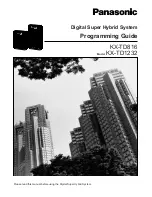
DGT / DGT60 / DGTQ / DGTP
36
-
TRANSMISSION IN MODBUS MODE
("ModbuS" parameter)
→
See the "MODBUS transmission" appendix, to be requested from the reseller.
-
TRANSMISSION IN PROFIBUS MODE
("ProFib" parameter)
→
See the "PROFIBUS (DGT4 PB, DGTQ PB, and DGTP PB) transmission" appendix, to be requested from the
reseller.
-
CONTINUOUS TRANSMISSION
("ALL.Std" "ALL.EXt" and “ALL.MAX” parameter)
This mode is used for interfacing to the PC, remote displays and other devices which request a constant
updating of the data independently from the weight stability.
The instrument transmits data with each converter read operation:
- With Baud rate at 9600 one can obtain up to 10 transmissions per second.
- With Baud rate at 115200 one can obtain up to 16 transmissions per second for the PC port, 12 for the
PRINTER port.
The transmission works with weight <, =, > 0 with approved or unapproved instrument.
The data is transmitted using the standard string (ALL.Std) or the extended string (or multiscale string in the
TRANSM mode) (ALL.EHt); see the paragraph 6.6 for the description of the 3 strings.
The “ALL MAX” transmission protocol is advisable for applications in which a high frequency of transmissions is
requested.
(up to 250TX/sec. with baud rate equal to 115200); the weight is transmitted in hexadecimal format (for example:
03E8= 1000g), without decimal point.
NOTE: The data transmission frequency increases or lessens depending on the frequency of the configured filter.
To obtain 250TX/sec one should configure the filter F.F.400 (
SEtuP
>>
ConFIG
>>
Param.
>>
StAbiL )
-
TRANSMISSION ON STABILITY
("StAb.St" and "StAb.EX" parameter)
Each time a weight on the scale becomes stable, a communication string is transmitted on the PC serial port.
For non approved instruments:
-
The transmission takes place if the weight is stable and the net weight is > 10 divisions.
-
Reenabling the transmission depends on how the "rEACt" step has been set in the SET-UP
environment (passage by zero of the NET weight or instability of the NET weight of 10 divisions; by
choosing "always" it works upon instability).
For approved instruments:
-
The transmission takes place if the weight is stable and the net weight is > 20 divisions.
-
Reenabling the transmission depends on how the "rEACt" step has been set in the SET-UP
environment (passage by zero of the NET weight or instability of the NET weight of 20 divisions; by
choosing "always" it works upon instability).
The data is transmitted using the standard string (StAb.St) or the extended string(or multiscale string in the
TRANSM mode) (StAb.EX); see the paragraph 6.6 for the description of the 3 strings.
-
RECEPTION OF THE REPE.6 STRING
("rEPE.6" parameter and
FModE
>>
Func
step set on rEPE)
If an instrument is connected which transmits the data with "rEPE.6" protocol, the indicator repeats the data of
the display and the indication leds of the connected instrument. If one enables the 485 address in the
SEtuP
>>
SEriAL
>>
CoM.Pc
>>
Add.En
step, the instrument repeats only if its machine code is the one requested (one
must put the machine code before the string). The instrument repeats also if a command with broadcast address
is received (99).
NOTE
: It is advisable to have a maximum number of receptions per second equal to 10.
-
RECEPTION OF THE STRING FROM REMOTE SCALE
("W.rEPE" parameter and
FModE
>>
Func
step set
on rEPE)
If an instrument is connected which transmits the data in continuous mode, the indicator repeats the transmitted
net weight.
Summary of Contents for DGT
Page 65: ...DGT DGT60 DGTQ DGTP 65 11 CONNECTION SCHEMES 11 1 DGT4 DGT60 DGT4 AN MOTHERBOARD I O BOOT J 1...
Page 68: ...DGT DGT60 DGTQ DGTP 68 11 2 DGT4 PB MOTHERBOARD I O BOOT J 1...
Page 71: ...DGT DGT60 DGTQ DGTP 71 11 3 DGTQ DGTQ AN BOARDS...
Page 72: ...DGT DGT60 DGTQ DGTP 72 I O BOOT J1 J2 CAL...
Page 76: ...DGT DGT60 DGTQ DGTP 76 11 4 DGTQ PB BOARDS...
Page 77: ...DGT DGT60 DGTQ DGTP 77...
Page 81: ...DGT DGT60 DGTQ DGTP 81 11 5 DGTP DGTP AN DGTP PB MOTHERBOARD...
















































